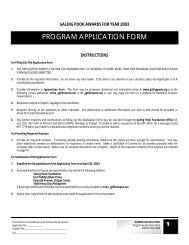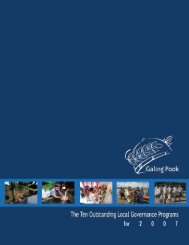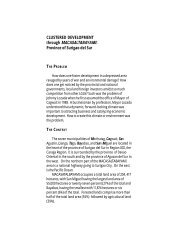kaban galing - front cover - galing pook
kaban galing - front cover - galing pook
kaban galing - front cover - galing pook
Create successful ePaper yourself
Turn your PDF publications into a flip-book with our unique Google optimized e-Paper software.
ANIAD was implemented in three phases:<br />
Phase I (1991-1994) focused on community organizing, lowland<br />
agricultural development, upland development and institutional<br />
development.<br />
Phase II (1994-1998) added gender sensitive community organizing,<br />
access and control of resources, sustainable productive use of resources<br />
and stronger institutional development.<br />
Phase III (1998-2003) strengthened sustainable crop and livestock<br />
industries, critical area protection and coastal resource management,<br />
with institutional development as a continuing component.<br />
Redemption<br />
In the uplands, the program developed around 2,000 hectares using<br />
sloping agricultural land technology (SALT). In the lowlands, microwatersheds<br />
and deep water impounding reservoirs were developed to<br />
provide irrigation to surrounding farms. Farmers are now able to plant<br />
twice a year, and in summer they plant vegetables. The reservoirs now<br />
also supply drinking water to farm animals grazing around them.<br />
In the coastal areas, marine sanctuaries were established, and fish<br />
wardens were deployed to implement fishery laws. Slowly the corals<br />
and mangroves grew healthier. Illegal fishing abated. Livelihood activities,<br />
such as seaweed culture and fish processing, increased. As a<br />
consequence, people’s income increased. Average annual income of<br />
fisherfolk increased from P11,000 in 1995 to P15,0000 in 2000.<br />
For the entire population, average annual income rose from P24,400<br />
in 1990 to P39,600 in 2002. Other improvements recorded were: safe<br />
drinking water for almost all households (from only 27% in 1990);<br />
electricity (from 39% to 78%); toilets (96%, with 80% water-sealed);<br />
access to telephones and cellular phones (from 3% in 1990 to 68% in<br />
2002); and increase in the number of appliances per household.<br />
Livelihood opportunities multiplied and production costs were<br />
reduced by 35% to 45%, land tenure of farmers improved, technical<br />
knowledge and skills of households were enhanced, along with improved<br />
skills, relationships and values of the populace.<br />
Sustaining Sustainability<br />
Many things still need to be done in terms of sustaining the programs<br />
within the existing designs and priorities. Other things beyond the<br />
Cycles, from Vicious to Virtuous 7












![[Year] Paano Tayo Aasenso? - Galing Pook Foundation](https://img.yumpu.com/3809385/1/184x260/year-paano-tayo-aasenso-galing-pook-foundation.jpg?quality=85)